Short lived supertruck For all its iconic status,
Page 24
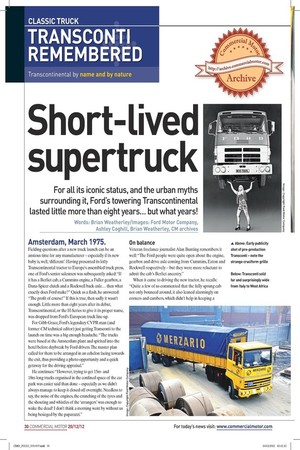
Page 25
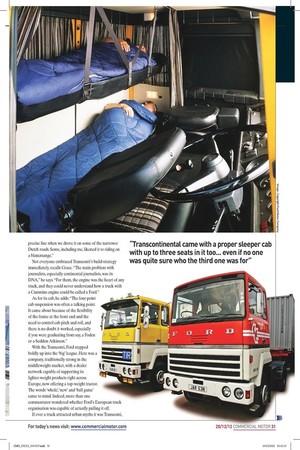
Page 26
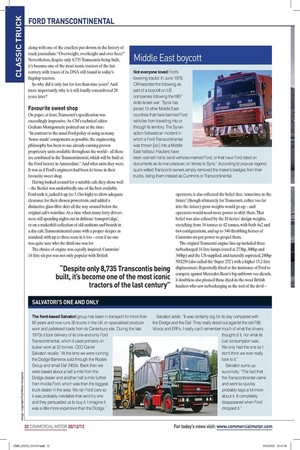
Page 27
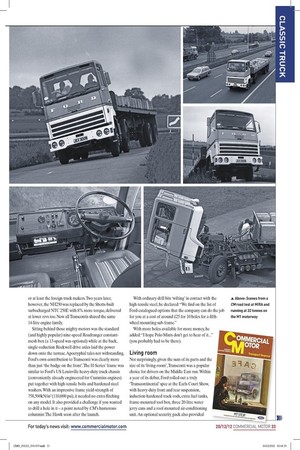
Page 28
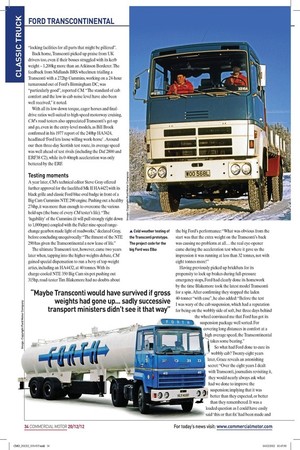
Page 29
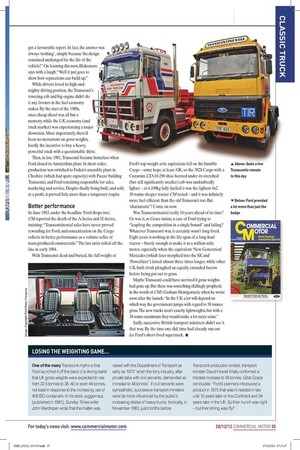
If you've noticed an error in this article please click here to report it so we can fix it.
Short lived supertruck For all its iconic status, and the urban myths surrounding it, Ford's towering Transcontinental lasted little more than eight years... but what years!
Words: Brian Weatherley/Images: Ford Motor Company, Ashley Coghill, Brian Weatherley, CM archives Amsterdam, March 1975.
Fielding questions after a new truck launch can be an anxious time for any manufacturer — especially if its new baby is, well, 'different'. Having presented its lofty Transcontinental tractor to Europe's assembled truck press, one of Ford's senior salesmen was subsequently asked: "If it has a Berliet cab, a Cummins engine, a Fuller gearbox, a Dana-Spicer clutch and a Rockwell back-axle... then what exactly does Ford make?" Quick as a flash, he answered: "The profit of course!" If this is true, then sadly it wasn't enough. Little more than eight years after its debut, Transcontinental, or the H-Series to give it its proper name, was dropped from Ford's European truck line-up.
For Gibb Grace, Ford's legendary CVPR man (and former CM technical editor) just getting Transconti to the launch on time was a big enough headache. "The trucks were based at the Amsterdam plant and spirited into the hotel before daybreak by Ford drivers. The master plan called for them to be arranged in an echelon facing towards the exit, thus providing a photo opportunity and a quick getaway for the driving appraisal."
He continues: "However, trying to get 15mand 18m-long trucks organised in the confined space of the car park was easier said than done — especially as we didn't always manage to keep it closed off overnight. Needless to say, the noise of the engines, the crunching of the tyres and the shouting and whistles of the 'arrangers' was enough to wake the dead! I don't think a morning went by without us being besieged by the paparazzi."
On balance Veteran freelance journalist Alan Bunting remembers it well: "The Ford people were quite open about the engine, gearbox and drive axle coming from Cummins, Eaton and Rockwell respectively — but they were more reluctant to admit the cab's Berliet ancestry."
When it came to driving the new tractor, he recalls: "Quite a few of us commented that the fully sprung cab not only bounced around, it also leaned alarmingly on corners and cambers, which didn't help in keeping a precise line when we drove it on some of the narrower Dutch roads. Some, including me, likened it to riding on a blancmange."
Not everyone embraced Transconti's build-strategy immediately, recalls Grace. "The main problem with journalists, especially continental journalists, was its DNA," he says. "For them, the engine was the heart of any truck, and they could never understand how a truck with a Cummins engine could be called a Ford."
As for its cab, he adds: "The four-point cab suspension was often a talking point. It came about because of the flexibility of the frame at the front end and the need to control cab pitch and roll, and there is no doubt it worked, especially if you were graduating from say, a Foden or a Seddon Atkinson."
With the Transconti, Ford stepped boldly up into the 'big' league. Here was a company, traditionally strong in the middleweight market, with a dealer network capable of supporting its lighter-weight products right across Europe, now offering a top-weight tractor. The words 'whole', 'new' and 'ball game' came to mind. Indeed, more than one commentator wondered whether Ford's European truck organisation was capable of actually pulling it off.
If ever a truck attracted urban myths it was Transconti, along with one of the cruellest put-downs in the history of truck journalism: "Overweight, overheight and over here!" Nevertheless, despite only 8,735 Transcontis being built, it's become one of the most iconic tractors of the last century, with traces of its DNA still found in today's flagship tractors.
So why did it only last for less than nine years? And more importantly, why is it still fondly remembered 28 years later?
Favourite sweet shop On paper, at least, Transconti's specification was exceedingly impressive. As CM's technical editor Graham Montgomerie pointed out at the time: "In contrast to the usual Ford policy of using as many 'home-made' components as possible, the engineering philosophy has been to use already-existing proven proprietary units available throughout the world — all these are combined in the Transcontinental, which will be built at the Ford factory in Amsterdam." And what units they were. It was as if Ford's engineers had been let loose in their favourite sweet shop.
Having looked around for a suitable cab, they chose well — the Berliet was undoubtedly one of the best available. Ford took it, jacked it up (to 3.15m high) to allow adequate clearance for their chosen powertrain, and added a distinctive glass-fibre skirt all the way around below the original cab's waistline. At a time when many lorry drivers were still spending nights out in dubious 'transport digs', or on a makeshift collection of old cushions and boards in a day cab, Transcontinental came with a proper sleeper as standard, with up to three seats in it too — even if no one was quite sure who the third one was for.
The choice of engine was equally inspired Cummins' 14-litre six-pot was not only popular with British operators, it also reflected the belief that, 'sometime in the future' (though ultimately for Transconti, rather too far into the future) gross weights would go up — and operators would need more power to shift them. That belief was also echoed by the H-Series' design weights, stretching from 34 tonnes to 42 tonnes, with both 4x2 and 6x4 configurations, and up to 340 throbbing horses of Cummins six-pot power to propel them.
The original Transconti engine line-up included three turbocharged 14-litre lumps (rated at 273hp, 308hp and 340hp) and the US-supplied, and naturally aspirated, 240hp NH250 (also called the 'Super 252') with a higher 15.2-litre displacement. Reportedly fitted at the insistence of Ford to compete against Mercedes-Benz's big unblown vee-diesels, it doubtless also pleased those dyed-in-the-wool British hauliers who saw turbocharging as the tool of the devil — or at least the foreign truck makers. Two years later, however, the NH250 was replaced by the Shotts-built turbocharged NTC 250E with 8% more torque, delivered at lower revs too. Now all Transcontis shared the same 14-litre engine family.
Sitting behind those mighty motors was the standard (and highly popular) nine-speed Roadranger constantmesh box (a 13-speed was optional) while at the back, single-reduction Rockwell drive axles laid the power down onto the tarmac. Apocryphal tales not withstanding, Ford's own contribution to Transconti was clearly more than just 'the badge on the front'. The H-Series' frame was similar to Ford's US Louisville heavy-duty truck chassis (conveniently already engineered for Cummins engines) put together with high-tensile bolts and hardened steel washers. With an impressive frame yield-strength of 758,500kN/in2(110,000 psi), it needed no extra flitching on any model. It also provided a challenge if you wanted to drill a hole in it — a point noted by CM's humorous columnist The Hawk soon after the launch.
With ordinary drill bits 'wilting' in contact with the high-tensile steel, he declared: "We find on the list of Ford-catalogued options that the company can do the job for you at a cost of around £25 for 10 holes for a fifthwheel mounting sub-frame."
With more holes available for more money, he added: "I hope Polo Mints don't get to hear of it..." (you probably had to be there).
Living room Not surprisingly, given the sum of its parts and the size of its `living-room', Transconti was a popular choice for drivers on the Middle East run. Within a year of its debut, Ford rolled out a truly 'Transcontinental' spec at the Earls Court Show, with heavy-duty front and rear suspension, induction-hardened track-rods, extra fuel tanks, frame-mounted tool box, three 20-litre water jerry cans and a roof-mounted air-conditioning unit. An optional security pack also provided "locking facilities for all parts that might be pilfered".
Back home, Transconti picked up praise from UK drivers too, even if their bosses struggled with its kerb weight — 1,200kg more than an Atkinson Borderer. The feedback from Midlands BRS wheelmen trialling a Transconti with a 272hp Cummins, working on a 24-hour turnaround out of Ford's Birmingham DC, was "particularly good", reported CM "The standard of cab comfort and the low in-cab noise level have also been well received," it noted.
With all its low-down torque, eager horses and finaldrive ratios well-suited to high-speed motorway cruising, CM's road testers also appreciated Transconti's get-up and go, even in the entry-level models, as Bill Brock confirmed in his 1977 report of the 240hp HA3424, headlined 'Ford lets loose willing work-horse' . Around our then three-day Scottish test route, its average speed was well ahead of test rivals (including the Daf 2800 and ERF38 C2), while its 0-40mph acceleration was only bettered by the ERE Testing moments A year later, CMs technical editor Steve Gray offered further approval for the facelifted Mk II HA4427, with its black grille and classic Ford blue oval badge in front of a Big Cam Cummins NTE 290 engine. Pushing out a healthy 274hp, it was more than enough to overcome the various hold-ups (the bane of every CM tester's life). "The `lugability' of the Cummins (it will pull strongly right down to 1,000rpm) coupled with the Fuller nine-speed rangechange gearbox made light of roadworks," declared Gray, A Cold weather testing of before concluding unequivocally: "The fitment of the NTE the Transconti prototype.
290 has given the Transcontinental a new lease of life." The project code for the The ultimate Transconti test, however, came two years big Ford was Elba later when, tapping into the higher-weights debate, CM gained special dispensation to run a bevy of top-weight artics, including an HA4432, at 40 tonnes. With its charge-cooled NTE 350 Big Cam six-pot pushing out 315hp, road-tester Tim Blakemore had no doubts about the big Ford's performance: "What was obvious from the start was that the extra weight on the Transconti's back was causing no problems at all... the real eye-opener came during the acceleration test where it gave us the impression it was running at less than 32 tonnes, not with eight tonnes more!"
Having previously picked up brickbats for its propensity to lock up brakes during full-pressure emergency stops, Ford had clearly done its homework by the time Blakemore took the latest model Transconti for a spin. After confirming they stopped the laden 40-tonner "with ease", he also added: "Before the test I was wary of the cab suspension, which had a reputation for being on the wobbly side of soft, but three days behind the wheel convinced me that Ford has got its suspension package well sorted. For covering long distances in comfort at a high average speed, the Transcontinental "takes some beating."
So what had Ford done to cure its wobbly cab? Twenty-eight years later, Grace reveals an astonishing secret: "Over the eight years I dealt with Transconti, journalists revisiting it, they would nearly always ask what had we done to improve the 09 suspension; implying that it was better than they expected, or better than they remembered. It was a loaded question as I could have easily said 'this or that fix' had been made and got a favourable report. In fact, the answer was always 'nothing' , simply because the design remained unchanged for the life of the vehicle!" On learning this now, Blakemore says with a laugh: "Well it just goes to show how reputations can build up."
While drivers loved its high-andmighty driving position, the Transconti's towering cab and big engine didn't do it any favours in the fuel-economy stakes. By the start of the 1980s, once-cheap diesel was all but a memory, while the UK economy (and truck market) was experiencing a major downturn. More importantly, there'd been no movement on gross weights, hardly the incentive to buy a heavy, powerful truck with a questionable thirst.
Then, in late 1981, Transconti became homeless when Ford closed its Amsterdam plant. In short order, production was switched to Foden's assembly plant in Cheshire (which had spare capacity) with Paccar building Transconti, and Ford remaining responsible for sales, marketing and service. Despite finally being built, and sold, at a profit, it proved little more than a temporary respite.
Better performance In June 1983, under the headline 'Ford drops two', CM reported the death of the A-Series and H-Series, insisting: "Transcontinental sales have never proved rewarding for Ford, and concentration on the Cargo reflects its better performance as a volume seller of mass-produced commercials." The last units rolled off the line in early 1984.
With Transconti dead and buried, the full weight of Ford's top-weight artic aspirations fell on the humble Cargo — some hope at least. OK, so the 3828 Cargo with a Cummins LTA10-290 shoe-horned under its stretched (but still significantly smaller) cab was undoubtedly lighter — at 6,109kg fully fuelled it was the lightest 4x2 38-tonne sleeper tractor CM tested — and it was infinitely more fuel-efficient than the old Transconti too. But 'charismatic'? Come on now.
Was Transcontinental really 10 years ahead of its time? Or was it, as Grace insists, a case of Ford trying to "leapfrog the competition in a single bound" and failing? Whatever Transconti was, it certainly wasn't long-lived. Eight years is nothing in the life-span of a long-haul tractor — barely enough to make it as a million-mile motor, especially when the equivalent 'New Generation' Mercedes (which later morphed into the SK and Towerliner) lasted almost three times longer, while other UK-built rivals ploughed an equally extended furrow before being put out to grass.
Maybe Transconti could have survived if gross weights had gone up. But there was something chillingly prophetic in the words of CMs Graham Montgomerie when he wrote soon after the launch. "In the UK a lot will depend on which way the government jumps with regard to 38 tonnes gross. The new trucks aren't exactly lightweights, but with a 38-tonne maximum they would make a lot more sense."
Sadly, successive British transport ministers didn't see it that way. By the time one did, time had already run out for Ford's short-lived supertruck. • Middle East boycott Not everyone loved Ford's towering tractor. In June 1978, CM reported the following as part of a boycott on US companies following the1967 Arab-Israeli war: "Syria has joined 13 other Middle East countries that have banned Ford vehicles from travelling into or through its territory. The Syrian action followed an incident in which a Ford Transcontinental was thrown [sic] into a Middle East harbour. Hauliers have been warned not to send vehicles marked Ford, or that have Ford listed on documents as its manufacturer, on ferries to Syria." According to popular legend, quick-witted Transconti owners simply removed the maker's badges from their trucks, listing them instead as Cummins or Transcontinental.
SALVATORI'S ONE AND ONLY The Kent-based Salvatori group has been in 80 years and now runs 35 trucks in the UK on work and palletised loads from its Canterbury 1970s it took delivery of its one-and-only Ford Transcontinental, which it used primarily on bulker work at 32 tonnes. CEO Daniel Salvatori recalls: "At the time we were running the Dodge Barreiros sold through the Rootes Group and small Daf 2400s. Back then we were based about a half a mile from the Dodge dealer and another half a mile further from Invicta Ford, which was then the biggest truck dealer in the area. We ran Ford cars so it was probably inevitable that we'd try one and they persuaded us to buy it. I imagine it was a little more expensive than the Dodge."
transport for more than specialised produce site. During the late Salvatori adds: "It was certainly big for the Dodge and the Daf. They really stood Volvos and ERFs. I really can't remember its day compared with out against the old F86 much of what the drivers thought of it, nor what its fuel consumption was. We only had the one so I don't think we ever really took to it."
Salvatori sums up succinctly: "The fact that the Transcontinental came and went so quickly probably says a lot more about it. It completely disappeared when Ford dropped it."
LOSING THE WEIGHTING GAME...
One of the many Transconti myths is that Ford launched it off the back of a strong belief that UK gross weights were expected to rise from 32.5 tonnes to 38, 40 or even 44 tonnes, not least in response to the increasing use of 40ft ISO containers. In his book Juggernaut, (published in 1981), Sunday Times writer John Wardroper wrote that the matter was raised with the Department of Transport as early as 1970 "when the lorry industry, after private talks with civil servants, demanded an increase to 44 tonnes". If civil servants were sympathetic, successive transport ministers were far more influenced by the public's increasing dislike of heavy trucks. Ironically, in November 1983, just months before Transconti production ended, transport minister David Howell finally confirmed a modest increase to 38 tonnes. Gibb Grace concludes: "Ford's planners introduced a product in 1975 that wasn't needed in law until 10 years later on the Continent and 34 years later in the UK. So their hunch was right — but their timing was iffy!"











































